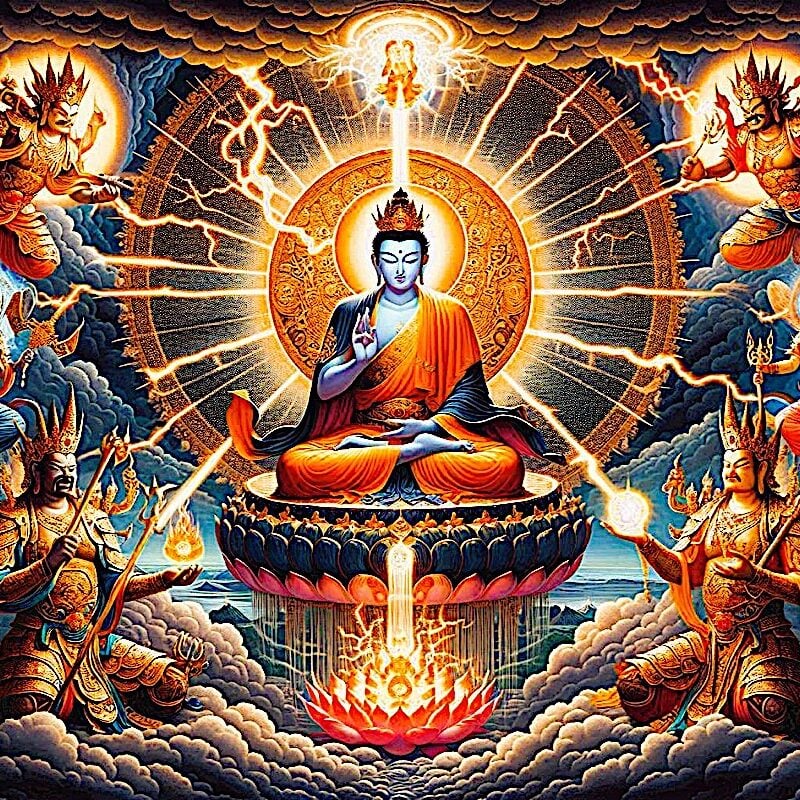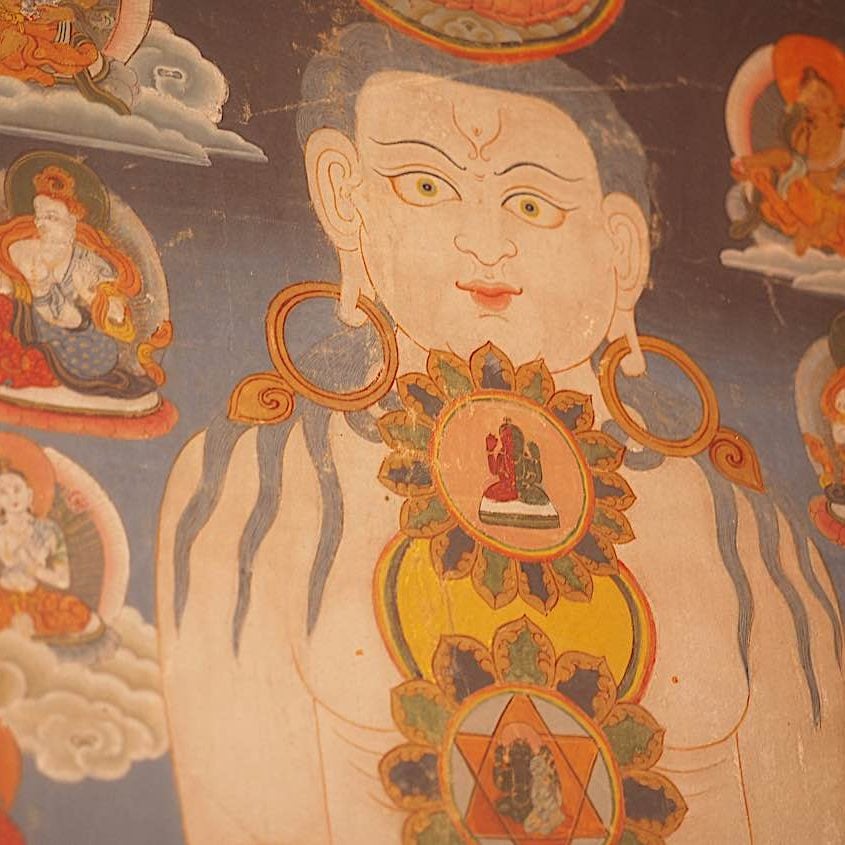Green Jambhala and Wisdom Dakini: The Karma Family Activity of Prosperity, aspects of Tara and Amoghasiddhi Buddha

Why is Green Jambhala with Mother Vasudhara Dakini the most important and prominent of the Jambhala mandala? Why is Green Jambhala’s activity so important to accomplishing Dharma merit?
Green Jambhala is the Karma Activity of Prosperity
For the same reason, we turn to Green Tara to save us; with her windy savior activity, we can rely on Green Jambhala (Dzambhala) and his co-equal Wisdom Mother Green-Blue Vasudhara Dakini to help us create the opportunity for good Karma, merit, and the resulting prosperity. This is, as with all Karma activities, for the benefit of all sentient beings.

The Karma Buddha Family of Amoghasiddhi and Tara are all about virtuous activities to accomplish the benefit of sentient beings.

- See our feature on Yellow Vasudhara Tara here>>
- See our special section of features on Tara here>>
- See our feature on Yellow Jambhala with an introduction to the five Jambhalas>>
- See our feature on White Mahakala Wealth Deity>>
The Purpose of Wealth in Dharma Practice: Generosity
What is the purpose of wealth in terms of Dharma? The purpose is not luxury, carefree living. The purpose is noble Dharma activities, helping all sentient beings. We share our wealth, and share the Dharma, and share our knowledge for the benefit of sentient beings.
If we do this, acting with generosity, we embody the activities of the Green Karma family. Green Jambhala and Wisdom Dakini will be sure to respond to our requests and mantras.

Green Jambhala Is the Most Important Jambhala
Green Jambhala (Dzambhala) is the most important of the Jambhalas, and the best known. Since he represents Karma activities, he accomplishes prosperity and affluence through the Karma family of Amoghasiddhi and Green Tara.
He is an emanation of Amoghasiddhi as Green Jambhala, while his co-equal Wisdom Dakini is a greenish-blue aspect of Vasudhara or Tara. As the Karma-Family “activity” they are the most active of the Five Jambhalas, and inspire positive karma in our lives.
As a member of the Karma Buddha family, his mantra includes the all-important word “karma” , which means activity, and “ah” which is the seed syllable of Amoghasiddhi.
You can think of the Activity couple as Air and Earth. Jambhala represents the windy karma activity of Amoghasiddhi, while the Wisdom Mother is none other than Vasudhara or Mother Earth, who is also Tara.

Different Lineages
Although it may seem confusing, in one teaching lineage, Green Dzambhala arises from Akshobya Buddha instead. Since there are five Jambhalas who arise from all five Buddha Families, there is no contradiction. In Buddhist terms, Enlightened Deities can assume countless forms and emanations. This is a matter of the lineage transmission and the purpose of our practice. For the purposes of this feature, we focus on Green Tara of the Kalachakra lineage, who arises from Amoghasiddhi and Tara.
The reason Green Jambhala is chief among the Jambhalas is the understing of Green in Vajrayana. According to the Himalayan Art.org experts:
“In Tantric literature, the color green is believed to be the union of all four principal colors and therefore represents all four activities: peaceful, increasing, powerful and wrathful.”
Combining all the activities into one is why Green Tara, Amoghasiddhi and Green Jambhala are the most popular.
Unique Attributes and Practice of Green Jambhala
Jeff Watt, on the Himalayan Art website describes Green Jambhala this way:
“Arya Jambhala, with a body green in colour, adorned with heavenly garb and all of the ornaments, seated in a playful manner. The right hand has the palm in a gesture of supreme generosity and holds a bijapuraka fruit. The left hand holds a treasure mongoose. Seated on the left thigh is the goddess Vasudhara, blue in color, the right hand in the gesture of supreme generosity and embracing the partner Jambhala.”
Although he is typically depicted with his co-equal wisdom Dakini, in solitary images or statues she is still understood to be present. She is the wisdom aspect of Green Jambhala, who is none other than green-blue Vasudhara Tara. He may be seen solitary — in which case his Wisdom Dakini is still present — or in full Yabyum, symbolic of the union of Compassionate Means, or Jambhala, with Wisdom or Green-Blue Vasudhara Dakini.
Green Jambhala Emanates from Amoghasiddhi and Tara
Green Jambhala is an emanation of Amoghasiddhi, the Buddha of the Karma Family, and his consort is Green-Blue Vasudhara Dakini, who is none other than an emanation of Green Tara. Like Karma Dakini Tara, she holds a lotus in one hand. When he appears in images with his consort, this symbolizes the embrace of Wisdom and Compassionate Means. When he is solitary, he is still considered to be the complete union of Wisdom and Compassionate Means, or Green Jambhala with Wisdom Karma Dakini together.
The stance of the Green Jambhala is active. His right leg stretches out like Tara, ready to leap to his feet, with his foot positioned atop a snail and a lotus flower. Meanwhile, his left leg is bent, adding a unique dynamic to his pose. Nehulay, a special kind of mongoose known to spew jewels from its mouth, rests in his left hand, while his right hand firmly holds a Citron fruit. The Citron is a beautiful fruit related to lemons, although much larger with a very thick skin. The Citron is widely used as a medicine.

Practicing Jambhala
The key to the efficacy of this practice lies not only in the repetition of the mantra but in the correct visualization and cultivation of pure motivation of Bodhichitta.
In one story of the five Jambhalas, Shakyamuni Buddha was attacked with rocks. The five Jambhalas manifested and saved him. Since then, as recorded in the teachings:
“In front of the Buddha, Green Dzambhala pledged to protect anyone that recited his mantra or named him.”
The offerings to Green Jambhala generally consist of water, flowers, incense, light, and music and lemons. A special offering is a Citron (or more commonly) a bowl of lemons, since he holds Citron in one hand. They are made with reverence, requesting the deity to shower blessings and liberate all beings from the suffering of poverty. Usually offerings are blessed first with the mantra:
Om Ah Hum
Mantra
His mantra does not require permission, but if you do not have empowerment, always visualize Jambhala and Wisdom Mother in front of you. You may not self-generate, or visualize yourself as the deity, without empowerment. The other requirement is Bodhichitta, and the wish to benefit all sentient beings. The mantra is:
Om Karma Jambhala Ah Svaha
- Om – represents the Body, Speech and Mind of the Buddhas. Om is derivative of AUM, where A is Enlightened Body, U is Enlightened Speech and M is Enlightened Mind. With Om, we are praising the Body, Speech and Mind of Dzambalah.
- Karma – means “activity” and is the name of the family from which Green Dzambhala emanates. He is an emanation of Amoghasiddhi and Tara of the Karma family.
- Jambhala – this syllable is the name of Dzambhala, which translates as ”Precious Wealth Deity” and in a mantra, his name draws him near, invoking him. Jam means “deity.” Bhah means wealth or gold. La means “to honor”
- Ah – is the seed syllable of the Karma family of Amoghasiddhi. For example, Amoghasiddhi’s mantra is Om Amoghasiddhi Ah Hum. Ah empowers the entire mantra with the karma-power of Amoghasiddhi and Tara.
- Svaha – this syllable translates as “well spoken” and contextually in an activity mantra such as this also means “let it be so” or “please manifest it so.”
A Simple Practice of Green Jambhala
To encourage the good karma activity of Green Jambhala and Wisdom Consort, it can be helpful to set up a small shrine or altar with a picture or statue of Jambhala, with incense, water, and tea offerings put out daily. Chant the mantra daily, ideally 3, 7, 21, or 108 times. As always with Buddhist practice, take Refuge in the Three Jewels first, then make offerings. Prostrate out of respect. Always finish by dedicating the merit for the benefit of all sentient beings. Without Buddhist Refuge and final dedication of merit, it’s not a Mahayana Buddhist Practice.
Refuge can be as simple as saying three times:
I take Refuge in the Three Jewels, Buddha, Dharma and Sangha, until I reach Enlightenment for the benefit of all sentient beings.
After mantras and offerings, the dedication can also be simple, but should be heart-felt.
I dedicate the merit of this practice to the cause for Enlightenment for the benefit of all sentient beings.
If you’d like to reinforce your request for specific help, you could modify the dedication along these lines:
I dedicate the merit of this practice to the cause for auspiciousness, prosperity, good health, for myself, my family, my teachers, my friends, so that we can practice the Dharma. Please actualize the karma activities of prosperity for the benefit of all sentient beings.
Whichever dedication you use, it should contain the aspiration to benefit all beings and ideally should be stated three times by tradition.
Likewise, we dedicate the merit of this feature article to the cause for Enlightenment for the benefit of sentient beings. May all beings benefit.
More articles by this author

Windhorse Tara Practice: Tara, the Wind of Life; Tara, Goddess of Wind, Buddha of Activity, Karma Mother

Protection from all Harm, Natural Disaster, Weather, Spirits, Evil, Ghosts, Demons, Obstacles: Golden Light Sutra: Chapter 14

Guru Rinpoche is ready to answer and grant wishes: “Repeat this prayer continuously” for the granting of wishes

VIDEO: Vajrapani Vajra Armor Mantra: Supreme Protection of Dorje Godrab Vajrakavaca from Padmasambhava
Search
Latest Features
Please support the "Spread the Dharma" mission as one of our heroic Dharma Supporting Members, or with a one-time donation.
Please Help Support the “Spread the Dharma” Mission!

Be a part of the noble mission as a supporting member or a patron, or a volunteer contributor of content.
The power of Dharma to help sentient beings, in part, lies in ensuring access to Buddha’s precious Dharma — the mission of Buddha Weekly. We can’t do it without you!
A non-profit association since 2007, Buddha Weekly published many feature articles, videos, and, podcasts. Please consider supporting the mission to preserve and “Spread the Dharma." Your support as either a patron or a supporting member helps defray the high costs of producing quality Dharma content. Thank you! Learn more here, or become one of our super karma heroes on Patreon.
Lee Kane
Author | Buddha Weekly
Lee Kane is the editor of Buddha Weekly, since 2007. His main focuses as a writer are mindfulness techniques, meditation, Dharma and Sutra commentaries, Buddhist practices, international perspectives and traditions, Vajrayana, Mahayana, Zen. He also covers various events.
Lee also contributes as a writer to various other online magazines and blogs.














